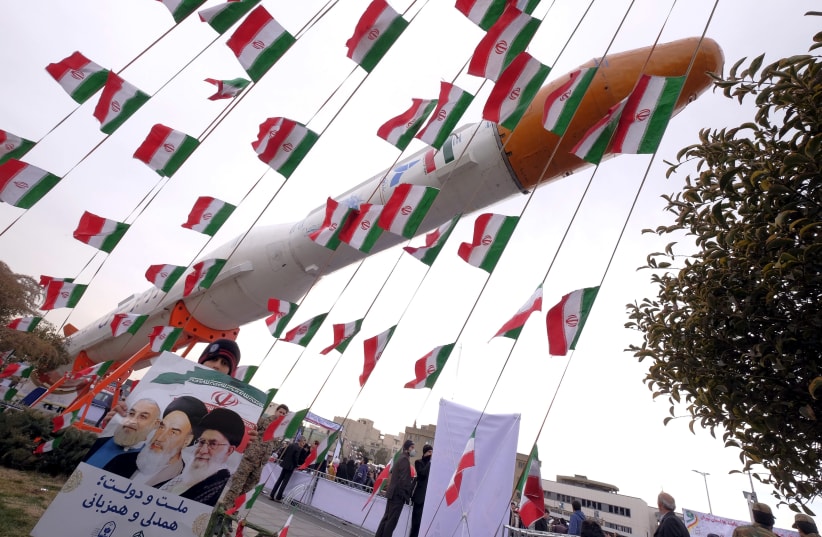The spokesperson of the Iranian Defense Ministry's Space Department stated that the satellite will be launched "at the first opportunity when everything is prepared." The spokesperson added that the launch process is complicated because of the need to test new technologies, according to the Iranian Tasnim news agency.
Barai stated that the satellite was scheduled to have launched last week, had passed all tests and there were "no issues for putting it in orbit," but did not clarify why the launch was delayed.
On Saturday, Sadjad Bonabi, an official from Iran's Telecommunications Infrastructures Company, announced that a cyberattack temporarily disrupted internet services in the country, but added that Iran's DEZHFA firewall had repelled the attack. Internet watchdog Netblocks reported a disruption in internet service in Iran on Saturday as well after authorities reported activated that "Digital Fortress" isolation mechanism.
According to Bonabi, the disruption was caused by a DDoS attack in which attackers attempt to make a network unavailable by sending too many requests to the IP of a country, causing an overload which leads to disruptions or crashes the network. The attack originated in East Asia and North America but did not seem to be the work of another government, according to Bonabi.
Nariman Gharib, a UK-based journalist and activist, stated that the botnet attack was "massive," according to Radio Farda, adding that the attack happened on the day that the Zafar satellite was supposed to be launched.
In December, Iran was targeted by three cyberattacks in the span of week. At the time, Mohammad-Javad Azari Jahromi, Tehran’s minister of communications and information technology, claimed the Islamic Republic’s national cybersecurity wall – known as Digital Fortress, or Dezhfa – has helped thwart 33 million cyberattacks against the country in the past year, according to Fars.
Over 100 reporters and a large group of students were waiting at the Imam Khomeini Spaceport in Iran on Friday, according to a tweet by Barari.
Last week, Iranian officials reported that the Islamic Republic was planning on launched a new scientific observation satellite in the "coming days."
Development of the "Zafar" (Victory) satellite began three years ago, said Morteza Barari, head of the country's national space agency, on Saturday. The 113-kilogram satellite will be launched by a Simorgh rocket.
Iranian Minister of Information and Communications Technology Mohammad Javad Azari Jahromi had said that the satellite would be launched before February 11, the anniversary of the Islamic Revolution, according to the Iranian Tasnim news agency.
Two versions of the satellite have been produced, in case the first launch fails. Information about the satellite will be "clearly publicized," according to Jahromi. Zafar will be used for telecommunications, imagery and "picking up space signals." The lifespan of the satellite is one year and six months.
The primary mission of the satellite will be collecting imagery, according to Barari. Iran's satellite program is for the "peaceful use of outer space. All our activities in the domain of outer space are transparent," said Barari, according to AFP.
The spokesman for the Iranian Defense Ministry’s Space Group announced on Monday that Iran is planning on revealing two new domestically made satellite carriers in "the near future," according to Tasnim. The statements came shortly before Iran confirmed that it would be launching a satellite soon.
The Islamic Republic is attempting to build solid-fuel satellite carriers and will reveal the "Sarir" and "Soroush" soon, according to the spokesman.
The Iranian Space Agency (ISA) hoped to construct five more satellites by March 2021.
Iran launched its first satellite "Omid" (Hope) into orbit in February 2009, according to the Iranian Fars news agency. A second satellite, "Rasad" (Observation), was launched in June 2011. A third, "Navid" (Promise), launched in February 2012.
Development of the "Payam 2" telecommunications satellite will begin by late May, according to Barari. Building the satellite will take up to four years. In January of last year, a satellite named Payam was launched by Iran, but failed to reach the "necessary speed" in the third stage of its launch due to technical problems, according to Fars.
Barari told Fars on Saturday that Iran is among the top five countries with a space station and among the top nine countries in the field of designing and making satellites. Iran will launch four more satellites into orbit between March 2020 and March 2021, according to Barari. "These will include two satellites for measurement and imaging and two others for IT purposes," said Barari.
Iran is also planning on sending astronauts to space with an "advanced country," said Barari to Fars.
"The talks are underway, and we hope to reach an agreement with one of the countries to commence the project," said Barari, who declined to name the country with which the ISA is speaking.
Iran's space aspirations suffered from three failed satellite launches in 2019: one in January, another in February and a third in August. The United States has warned Iran against rocket launches, fearing the technology used to put satellites into orbit could help it develop the ballistic missile capability needed to launch nuclear warheads, though Tehran denies its activity is a cover for such development.Reuters contributed to this report.
